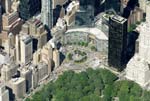
|

|
|
Home Site Search Contact Us Subscribe
|
|
|
INSIGHT: Let's Quiet Down: The Case for Places, Regionalism, and Sustainability Architecture should be concerned primarily with place-making, not object-making. By Peter Gisolfi, AIA, ASLA, LEED AP May 30, 2012 Recently, an eminent speaker at the Spitzer School of Architecture at the City College of New York devoted his lecture to an art gallery in Great Britain. When it became clear that the building, albeit distinguished, had no discernable connection to its setting, I lost interest. Architecture should be concerned primarily with place-making, not object-making. Why doesn’t everybody agree with me? Isn’t it obvious that buildings must belong where they are sited?
To understand more clearly the
issue of place, consider the two southern corners of Central Park in New York City. At the southeast corner on 5th Avenue at 59th Street is Edward Durell Stone
and Emery Roth & Sons’
General Motors Building (1968). It fights
with its setting. It diminishes Grand Army Plaza across the avenue. It does not
contribute to the place. At the southwest corner is SOM’s Time Warner Center. This building is sympathetic to Columbus Circle. It reinforces the energy of the
swirling traffic around the fountain plaza at the center. It enhances the
place.
Put simply, the Time Warner Center is an elaborate edge building that helps define an outdoor room – Columbus Circle. The GM Building replaced a building that once formed the eastern edge of the plaza in front of the Plaza Hotel. By setting the GM tower back from the street, the defining edge of the plaza was eliminated, and a sterile streetscape created. The urban design failure of the GM Building is well known; it results from a lack of regard for the outdoor space. The success at Columbus Circle results from following the curve of the circular plaza, an idea unrealized by the predecessor buildings. Neither building is a masterpiece, but a building does not have to be a masterpiece to fulfill its role of enhancing the place.
What makes a place? How do we define place?
• The Harvard Yard is a place – austere, red brick dormitories, diagonal paths, deciduous trees giving shade, and occasional buildings of greater importance that emerge ambiguously, partly obscured by dense vegetation. • Savannah, Georgia, is a place – a gridded city plan with the repetitive quilt of open parks established by that grid, its regularity interrupted by diverse buildings, a variety of parks, and the irregularities of the live oaks – a gridded yet whimsical place. • Beacon Hill in Boston is a place – sloping narrow streets, tall brick townhouses, the recurring module of the buildings, the repetition of standard materials, the subtle variety of building forms. • Bryant Park and its surroundings between 40th and 42nd Streets and 5th and 6th Avenues in Manhattan is a place – a grand, Parisian-like park with stately plane trees, an open lawn, a neoclassical public library, and crowds of office workers, all surrounded by office buildings creating a continuous street wall.
Despite our obsession with style, it is more revealing to categorize urban buildings as either edge buildings or object buildings. Most older cities in the United States are constructed primarily of edge buildings. Manhattan is populated predominately by edge buildings, although object buildings became more fashionable in the second half of the 20th century. Edge buildings define the perimeter of outdoor spaces; they hold the street wall, maintain the urban fabric and, to some extent, suppress their individual identities, at least at street level. Object buildings are surrounded by outdoor space; they break the fabric and call attention to themselves. Yet they are often necessary and appropriate. Consider Low Library at Columbia University, Riverside Church along Riverside Drive, Grant’s Tomb nearby, or the Lincoln Memorial in Washington, DC. In each of these settings, the object building is appropriate as a focal point.
Occasionally, the object building may be more subtle. Consider New York City’s Seagram Building, an icon of Modernism by Mies van der Rohe and Philip Johnson, which is set back from the east side of Park Avenue on its own plaza. Yet, it relates elegantly to the New York Racquet Club by McKim, Meade & White across the street, a neoclassical building that defines a clear western edge of the plaza in front of the Seagram tower.
Global vs. regional architecture
Architectural styles come and go. In the 20th century, we saw the rise of Modernism, the International style, Brutalism, Postmodernism, and Deconstructivism, among others. Global architecture is a more current – and pejorative – term for what used to be referred to as the International style, which emerged in the 1930s. It seems the basic tenet of global architecture is that buildings should be free-standing with little reference to anything else. Consider buildings by well-known American architects that have received a lot of press:
• Peter Eisenman describes his City of Culture in Santiago de Compostela as having “erupted and heaved up” from the ground. Does this artificial topography relate to the surrounding landscape? • César Pelli’s Petronas Towers in Kuala Lumpur are enormous, tapering, twin towers connected by a sky bridge, overpowering the cityscape. • And is there an exposed hilltop or open space anywhere in the world that cannot be enhanced by a Frank Gehry titanium sculpture?
Am I out of date advocating regional architecture? Remember that Brunelleschi never left Florence, and he thrived. Regional architecture is related to the local climate and the traditions of a place. Buildings in a hot, dry climate should be designed and constructed differently from buildings in a hot, humid climate, and should be dramatically different from buildings in a cold climate. Here in the northeast, we are challenged by the most difficult climate of all – at times cold, other times hot, and often humid. Regional traditions evolve over time, often without architects. Regionalism is not primarily concerned with style; it is based on adaptive behavior.
As architects, we should learn to open our eyes and see what is there. If a place already exists (as in the Edward Durell Stone example), shouldn’t it be our primary task to understand that place and enhance it? If regional traditions have evolved and are in evidence, shouldn’t we use them? Perhaps if the place does not yet exist, we can help create it.
The concepts of regionalism and place-making are connected naturally to sustainability because regional buildings are intrinsically sustainable, and regionally appropriate places relate to local climate and other aspects of physical geography. The tasks of architectural design and the creation of places are more cerebral pursuits than simply building another object.
Closing thoughts
Recently, I visited the cities of New Orleans and Dallas. I stayed in the center of Dallas, where reliable masonry edge buildings are being systematically removed and replaced by open parking lots and randomly placed glass towers (objects) that appear to be temporary and unrelated to the setting. Dallas is evolving into a chaotic urban landscape with no sense of place.
New Orleans will always be threatened by floods, the eternal disaster of the levees that may fail, and the rising Mississippi. But the original French planning grid is there; Jackson Square is there; the French Quarter and the Garden District are there. New Orleans is a city with an identity. It is a place.
The fundamental task of architecture is to create or enhance places. Most often, the place or significant aspects of the place exist before we start. Our job is to pay attention. The alternative is the shouting match between objects competing for our attention that is becoming so commonplace. Let’s quiet down.
Peter Gisolfi, AIA, ASLA, LEED AP, is a professor of architecture and landscape architecture and chairman of the Spitzer School of Architecture at the City College of the City University of New York. He is also the founding partner of Peter Gisolfi Associates, architects and landscape architects of Hastings-on-Hudson, New York, and New Haven, Connecticut, where he is the principal-in-charge of design. His articles and essays have been widely published nationally. His book, Finding the Place of Architecture in the Landscape, expresses his ideas about architecture and landscape architecture, and their relationship to setting. Contact him at pgisolfi@petergisolfiassociates.com.
Also by Gisolfi:
INSIGHT: Small-Scale
Solution to Alternative Energy Resistance
INSIGHT:
Collaboration and Compromise: A Misunderstood Aspect of the Design Process
INSIGHT: Save What's
Left: Architects as Stewards of Our Planet
|
(click on pictures to enlarge)  Bing Maps Columbus Circle  Peter Gisolfi Harvard Yard |
© 2012 ArchNewsNow.com